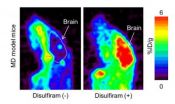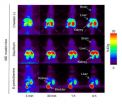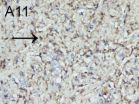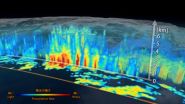(Press-News.org) Scientists at the RIKEN Center for Life Science Technologies have used PET imaging to visualize the distribution in the body of copper, which is deregulated in Menkes disease, a genetic disorder, using a mouse model. This study lays the groundwork for PET imaging studies on human Menkes disease patients to identify new therapy options.
Menkes disease, though rare, is a fearsome genetic disorder. Most affected babies die within the first few years of life. The disease is caused by an inborn fault in the body's ability to absorb copper. The standard treatment today for the 1 in 100,000 babies affected by the disorder is to inject copper, but this therapy has limited efficacy. Eventually the treatment becomes ineffective, leading to neurodeneration, and the copper accumulates in the kidneys, sometimes leading to renal failure.
As a result, treatments have been sought that enhance the accumulation of injected copper in the brain while preventing its accumulation in the kidney. Recently, disulfiram, a drug developed to treat alcoholism, has been suggested as a therapy for Menkes disease, since one of its actions is to enhance this copper accumulation in the brain.
Now, in a landmark study published in the Journal of Nuclear Medicine, scientists at the RIKEN Center for Life Science Technologies in Kobe, Japan, in collaboration with paediatricians from Osaka City University and Teikyo University, have used positron emission tomography (PET) to show that a combination of copper injections and disulfiram or D-penicillamine allows a greater movement of copper to the brain, where it is needed, without accumulating in the kidneys.
In the study, the researchers used Menkes Disease model mice, which have an inborn defect in copper metabolism, and injected copper-64, a radioactive isotope of copper, into the mice. They then used PET scanning, a non-invasive procedure, to visualize how the copper moved throughout the body. They compared mice injected with copper alone to mice injected with copper along with one of two other drugs, disulfiram or D-penicillamine, and the distribution of the copper throughout the body was observed for a four-hour period.
The results showed that the mice given copper along with disulfiram had a relatively high concentration of copper in the brain without a significant increase in the kidneys. Surprisingly, it showed that the amount of copper going to the brain in mice treated with disulfiram was actually higher than in those treated with copper alone, suggesting that the drug has an effect on the passage of copper through the blood-brain barrier.
According to Satoshi Nozaki, one of the co-authors, "This study demonstrates that PET imaging can be a useful tool for evaluating new treatments for Menkes disease." Looking to the future, he said, "Based on this study, we are planning to conduct clinical PET studies of patient with Menkes disease."
INFORMATION:
For more information please contact:
Juliette Savin
RIKEN
Tel: +81-(0)48-462-1225
Mobile phone: +81-(0)80-8895-2136
Email: pr@riken.jp
This press release is online at: http://www.riken.jp/en/pr/press/2014/20140326_1/
Reference:
Shiho Nomura, Satoshi Nozaki, Takashi Hamazaki, Taisuke Takeda, Eiichi Ninomiya, Satoshi Kudo, Emi Hayashinaka, Yasuhiro Wada, Tomoko Hiroki, Chie Fujisawa, Hiroko Kodama, Haruo Shintaku, Yasuyoshi Watanabe, "PET Imaging Analysis with 64Cu in Disulfiram Treatment for Aberrant Copper Bio-distribution in Menkes Disease Mouse Model", The Journal of Nuclear Medicine, 2014, doi: 10.2967/jnumed.113.131797
About RIKEN
RIKEN is Japan's largest research institute for basic and applied research. Over 2500 papers by RIKEN researchers are published every year in leading scientific and technology journals covering a broad spectrum of disciplines including physics, chemistry, biology, engineering, and medical science. RIKEN's research environment and strong emphasis on interdisciplinary collaboration and globalization has earned a worldwide reputation for scientific excellence.
Website: http://www.riken.jp/en/ Find us on Twitter at @riken_en
About the Center for Life Science Technologies (CLST)
The RIKEN Center for Life Science Technologies aims at the development of key technologies for breakthroughs in medical and pharmaceutical applications by conducting ground-breaking research and development programs for next-generation life sciences. CLST comprises the Division of Structural and Synthetic Biology, the Division of Genomic Technologies, and the Division of Bio-function Dynamics Imaging, which will work together in this endeavor. Research and development programs are carried out in collaboration with companies, universities, and international consortia, in order to disseminate the center's achievements to the global community.
Website: http://www.clst.riken.jp/en/index.html
Using PET scanning to evaluate therapies of Menkes disease
2014-03-26
ELSE PRESS RELEASES FROM THIS DATE:
Diabetes: Good self-management helps to reduce mortality
2014-03-26
Scientists of the Institute of Health Economics and Health Care Management (IGM) and of the Institute of Epidemiology II (EPI II) at Helmholtz Zentrum München (HMGU), together with colleagues of the German Diabetes Center (DDZ) in Düsseldorf, investigated the association between self-management behavior and mortality in patients with type 2 diabetes. HMGU and the DDZ are partners in the German Center for Diabetes Research (DZD).
High self-management index – low mortality
340 study participants with type 2 diabetes were interviewed with regard to their patient behavior ...
Real-life CSI: What can investigators really tell from gunshot residue?
2014-03-26
The popular TV series "CSI" is fiction, but every day, real-life investigators and forensic scientists collect and analyze evidence to determine what happened at crime scenes. In a study published in the ACS journal Analytical Chemistry, scientists say they have developed a more rapid and accurate method that could allow crime scene investigators to tell what kind of ammunition was shot from a gun based on the residue it left behind.
Igor K. Lednev and Justin Bueno point out that when someone fires a gun, burnt particles from the bullet spray out of the weapon onto a ...
Electroacupuncture at Conception and Governor vessels and hUCB-MSCs for cerebral ischemia
2014-03-26
Mesenchymal stem cell transplantation is a novel means of treating cerebral ischemia/reperfusion, and can promote angiogenesis and neurological functional recovery. Acupuncture at Conception and Governor vessels also has positive effects as a treatment for cerebral ischemia/reperfusion. Therefore, Prof. Haibo Yu and co-workers from Affiliated Shenzhen Traditional Chinese Medicine Hospital, Guangzhou University of Chinese Medicine in China hypothesized that electro-acupuncture at Conception and Governor vessels plus mesenchymal stem cell transplantation may have better therapeutic ...
Beer marinade could reduce levels of potentially harmful substances in grilled meats
2014-03-26
The smells of summer — the sweet fragrance of newly opened flowers, the scent of freshly cut grass and the aroma of meats cooking on the backyard grill — will soon be upon us. Now, researchers are reporting that the very same beer that many people enjoy at backyard barbeques could, when used as a marinade, help reduce the formation of potentially harmful substances in grilled meats. The study appears in ACS' Journal of Agricultural and Food Chemistry.
I.M.P.L.V.O. Ferreira and colleagues explain that past studies have shown an association between consumption of grilled ...
Research produces strong evidence for a new class of antidepressant drugs
2014-03-26
Scientists have shown for the first time that a chemical in the brain called galanin is involved in the risk of developing depression.
And the research, undertaken by a European research team, points to a strong reason to develop drugs that modify galanin functioning as a new class of antidepressant drug.
Galanin is a neuropeptide (a small protein) that was discovered and investigated over 30 years ago by various groups including the Swedish scientist Tomas Hokfelt. He is one of the senior authors of the paper published in the journal PNAS.
Professor Hokfelt and ...
First images available from NASA-JAXA global rain and snowfall satellite
2014-03-26
NASA and the Japan Aerospace Exploration Agency (JAXA) have released the first images captured by their newest Earth-observing satellite, the Global Precipitation Measurement (GPM) Core Observatory, which launched into space Feb. 27.
The images show precipitation falling inside a March 10 cyclone over the northwest Pacific Ocean, approximately 1,000 miles east of Japan. The data were collected by the GPM Core Observatory's two instruments: JAXA's Dual-frequency Precipitation Radar (DPR), which imaged a three-dimensional cross-section of the storm; and, NASA's GPM Microwave ...
The advantages of entering the workforce in a recession
2014-03-26
Despite the well-documented disadvantages of graduating from college during a recession, could graduates actually be happier with their jobs in the long run?
A new article from Administrative Science Quarterly examines whether earning a college or graduate degree in a recession or an economic boom has lasting effects on job satisfaction. Across three studies, well-educated graduates who entered the workforce during economic downturns were happier with their work than those who first searched for jobs during more prosperous times. In fact, they were happier with their ...
Immunotherapy data heralds new era of lung cancer treatment
2014-03-26
Geneva, Switzerland, 26 March 2014 -- A new era of lung cancer therapy is close to dawning, using drugs that can prevent tumour cells from evading the immune system, experts have said at the 4th European Lung Cancer Congress.
For decades, scientists and doctors thought immunotherapy –treatments that harness the immune system to fight a disease-- was of marginal benefit in lung cancer, says Jean-Charles Soria, Institute Gustave Roussy in Paris, France.
However a new class of drugs known as "immunocheckpoint regulators" have shown huge potential, Soria says. New data ...
Planning and building products and production plants simultaneously
2014-03-26
In early 2010, LANXESS decided to enter a new field of business, water purification: A production facility for Lewabrane reverse osmosis membrane filter elements was supposed to be built by the fall of 2011. Together with the company's experts, researchers from the Fraunhofer Institute for Factory Operation and Automation IFF in Magdeburg designed and had the manufacturing technology ready for production in just nine months. Afterward, they built a second, fully automatic and, therefore, more complex plant in just one year. Part of this plant – scaled down – will be on ...
Harvard scientists visualize new treatments for retinal blindness
2014-03-26
A new report published online in The FASEB Journal may lead the way toward new treatments or a cure for a common cause of blindness (proliferative retinopathies). Specifically, scientists have discovered that the body's innate immune system does more than help ward off external pathogens. It also helps remove sight-robbing abnormal blood vessels, while leaving healthy cells and tissue intact. This discovery is significant as the retina is part of the central nervous system and its cells cannot be replaced once lost. Identifying ways to leverage the innate immune system ...




